MODE 1.0 and 1.1.2 (for use with Max/MSP 4.5) for Mac OS X, US$ 199; available from Cycling 74, 379A Clementina Street, San Francisco, California 94103, USA; telephone (+1) 415-974-1818; fax (+1) 415-974-1812; electronic mail info@cycling74.com; Web www.cycling74.com/products/mode.html.
Margaret Cahill
Limerick, Ireland
MODE is a collection of plug-ins for use with VST, Audio Units, and RTAS hosts running on Macintosh OS X platforms. The core of MODE consists of five main plug-ins, components of which are available as 18 smaller mini-plug-ins, bringing the total number in the set to 23. Three of the plug-ins are virtual instruments that receive MIDI and generate audio. The remaining two are effects plug-ins. MODE was created by CreativeSynth and is distributed by Cycling 74; it is based on Pluggo technology. Pluggo is a collection of more than 100 plug-ins available from the same company for use with the same host applications, and users of Pluggo will find some familiar features in MODE.
The 18 mini-modules in MODE form substantial plug-ins, ranging from various types of delay, filter, and distortion effects, to an arpeggiator, a step sequencer, and synthesizer instruments. The five main plug-ins are made up of various combinations of these modules and are therefore quite complex. In one plug-in alone I counted 72 parameters that could be set by the user. Each has a particular main synthesizer or effect feature as its core but then may include a combination of filter, delay, low frequency oscillator (LFO), pan controls, distortion effects, etc. The designers set out to create a set of plug-ins that would guide the user toward experimentation, with the nature of the sound influencing choices.
The user mainly deals with knobs and sliders that control parameter settings but do not indicate the parameter value, or allow the user to enter precise data values. Some of the main plug-ins have as many as 128 presets and most of the smaller modules have their own individual presets, again some with as many as 128, giving the beginner an easy way to start playing with the various synthesizers and effects. The time-based plug-ins in the package provide the option to synchronize with a host application, and many key parameters can be controlled using MIDI controllers.
BANG is described as a “tuned percussion
synth.” It is
made up of four main modules: a sample playback module, an FM synthesizer,
an analog-type synthesizer, and a stereo delay with a master output
with filter and distortion, all of which are available as separate
plug-ins. The sample playback section provides a set of percussion
samples, with a five-stage envelope with time stage values of 0 to
1500 ms (see Figure 1). 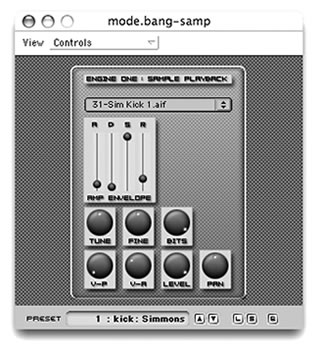 Controls
for coarse and fine tuning of the base frequency and a bit reduction
control with range of 1- to 24-bits are provided, along with controls
that allow velocity to control the sampling playback speed and output
level. A send (to the Stereo Delay), level, and pan complete this and
the other two modules.
Controls
for coarse and fine tuning of the base frequency and a bit reduction
control with range of 1- to 24-bits are provided, along with controls
that allow velocity to control the sampling playback speed and output
level. A send (to the Stereo Delay), level, and pan complete this and
the other two modules.
The FM synthesizer section of this plug-in includes carrier and modulator envelope controls as above and controls for pitch and waveform of each (sine, triangular, sawtooth, square, or noise). Detailed control is allowed over the amplitude and pitch of the modulation and a MIDI tracking feature causes the modulating oscillator to follow the MIDI notes played.
The analog synthesizer module also has two five-stage envelope controls, controls for pitch, waveform, modulation amount, velocity controls for pitch and output level, and an invert envelope choice. A low-pass filter with a range of 20-12,000 Hz is also included, with cut-off frequency, resonance control, and a parameter that modulates the frequency cut-off based on the modulation envelope.
The delay module has coarse
and fine time controls of 5-300 ms and +/-10 ms, respectively. The
delay time can be modulated by 1-20 Hz
values to create chorus and quivering sounds and the depth can be
controlled. Feedback gain is also available.
The final module of the BANG plug-in is the Master output which includes
a choice of low-, high- or band-pass filter with distortion, level,
and pan parameter settings. Each of the sample-playback, FM synthesizer,
and analog synthesizer modules have an on/off switch so they can
be used simultaneously or separately.
Although BANG was designed as a percussion
synth, the sheer number of parameters available to the user means that
it can be used to shape
and tweak many types of sounds.
The MONO plug-in is a monophonic FM synthesizer, with two parallel
oscillators, an arpeggiator, distortion, filter, and delay modules.
Each of these modules is available as an individual plug-in with the
filter and distortion modules combined into one. The carrier and modulator
controls are similar to those in BANG, with MIDI tracking of carrier
and modulator pitch an option. LFO rate and depth controls and a pan
and output level control are available for each oscillator.
One of the key features of this plug-in is the arpeggiator module (see
Figure 2).
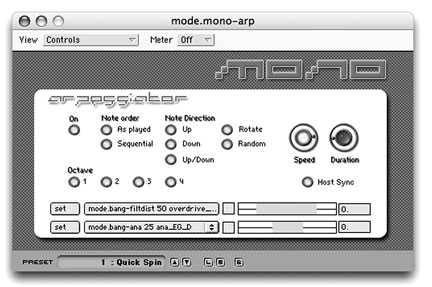
Note inputs on the keyboard can be output in the order played or in sequential order, with options to alter the sequence direction from bottom-up, top-down, up and down, rotated around the top note, or randomly. A range of one to four octaves is available to extend the ambitus of pitches and the tempo of notes output can be specified in terms of beats-per-minutes (25 to 1,000 BPM) or can be synchronized to the host timing in resolutions of whole notes to 32nd notes. The length of notes can be set from 25 to 1,000 ms.
The distortion module of the plug-in provides a graphical 8-bit waveshape designer with 64 positive settings that are mirrored to negative levels. A choice of low-, band- and high-pass filter types with cut-off frequency control of 40 Hz to 14 kHz and a control linking velocity to modulation of the cut-off frequency are contained in the filter module. Finally, the delay module features vertical sliders to control coarse and fine timing (5 to 2,000 ms and +/-5 ms, respectively), feedback, filter cut-off frequency, and a wet/dry control. Separate left and right controls are provided for the time and feedback parameters. An overall pan and level control for the plug-in is also provided.
MONO is a pleasant to use plug-in with colored knobs that change from grey, to light blue, to a strong glowing blue as the knob is moved from left to right, giving an overview of all settings at a glance. A wide range of sounds can be created and the distortion and arpeggiator modules are especially useful for unusual and original sounds. The arpeggiator module is available as a modulator plug-in which allows the user to set or scale parameters of other plug-ins based on the output from the arpeggiator. Pluggo users will be familiar with using modulator plug-ins, which can be quite useful and flexible tools.
The polyphonic synthesizer in this collection, POLY, consists of two oscillators, a filter, an arpeggiator, two four-stage envelopes, two six-stage LFOs, a chorus, and a delay (see Figure 3).
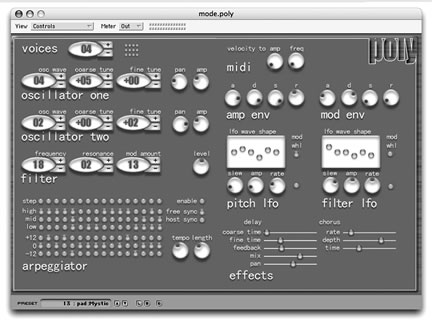
A choice of 24 12-bit waveform samples can be chosen for the oscillator wave types. Twenty-four negative and positive steps of coarse and fine frequency tunings are available along with amplitude and pan controls. The filter cut-off frequency, resonance, and filter modulation settings are also divided into 24 steps. A pitch and filter LFO features a six-step sequencer that can be used to design a waveshape, with a slew control to smooth it out. The pitch LFO controls the pitch of both oscillators and the output of the LFO can be scaled using the modulation wheel. The depth and speed of the LFO can also be controlled. A single LFO with parameter controls is available as an individual modulator plug-in and can be used, for example, to change a filter cut-off frequency or a delay time. The delay controls feature coarse and fine timer settings, feedback, pan, and mix controls. The chorus rate (0.1 ms to 12.5 ms), depth, and time (4 to 460 ms) can be controlled by the user.
One of the most fun modules in the MODE collection is the polyphonic arpeggiator included here. Like the arpeggiator mentioned above, the tempo can be specified by the user or slaved to the tempo of the host, and the duration of the output notes can be altered. When a chord is played, the notes are divided into high, mid, and low ranges according to pitch. Sixteen selectors are available for choosing which pitches should play for each step of the arpeggiator output. The high, mid, and low notes can be turned on or off and can be played simultaneously or individually at the input pitch level or shifted up or down an octave. Combined with the delay, chorus, LFO, and main synthesizer, the arpeggiator can create long rhythmic sequences of sound from basic chords and is ideal for reinforcing existing beats and stresses. The synthesizer, chorus, and LFO modules are available as individual plug-ins.
The SPIN plug-in is a time-based, multi-effects plug-in with host synchronization, filter, distortion, panning, delay, and, unusually, a volume sequencer (see Figure 4).
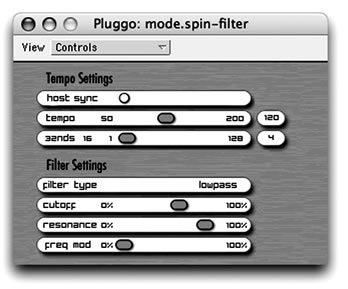
As in similar timing modules, the user can set the tempo or choose to synchronize to the host. A timing step parameter allows the user to set the step value for the master clock. This value will affect the modulation of the filter, the panner rotation speed, the volume sequencer speed, and the delay time. The filter parameters are much the same as previous modules but the cut-off upper limit is higher at 20 kHz. A distortion module offers an overdrive and bit-crunch parameter.
The volume sequencer
is the key feature of this plug-in, and although we are used to seeing
step-sequencers for pitch, this works in a similar
way but with volume gate controls. Sixteen volume sliders can be
used to set the gate depth for each step and a slew parameter for setting
the amount of smoothing between step values is also provided.
All of the above-mentioned elements of SPIN are available as individual
plug-ins, and all except the distortion plug-in have the tempo controls.
Even the mini-plug-ins that use the tempo settings are great fun,
and lots of interesting effects can be created by playing around
with the
step value. Altering this parameter with the POLY-LFO modulator plug-in
means that you can program small- or large-scale changes in the timing
controls for various effects. Incidentally, I did use most of the
Pluggo modulator plug-ins to control MODE parameters and could see
lots of
interesting ways to combine both collections.
The final MODE plug-in, WASH, is a looping delay that consists of six normal delay lines with a patching matrix to route outputs to delay inputs and set audio outputs (see Figure 5).
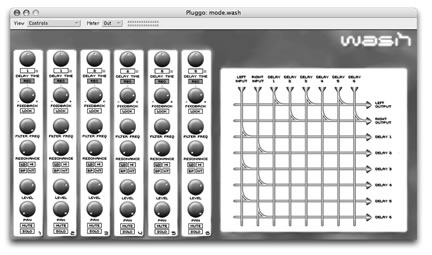
Along with the expected delay time controls (up to 10 seconds) and feedback settings on each line, Lock and Record buttons allow the user to lock in a loop to the delay line. Using the patching matrix, the outputs from any delay line can be routed to any other or to an audio output. As each delay line can record further loops, a simple input can be transformed into a complex “wash” of sound. The patching matrix allows for huge flexibility and experimentation on the part of the user. A choice of filters is also available on each delay line. A single channel looping delay line is also provided.
A Parameter Change Pop-up Menu (as found in Pluggo), is available by command-clicking in a plug-in window. Useful features are provided for sending updated parameter settings to the host, undoing changes, randomly setting parameter values, and an “evolve” option that alters each parameter by a random amount up to five percent. A level meter is displayed on all plug-in windows and can be set to display the input or output levels or can be switched off.
I experimented mainly with the Audio Units version of MODE residing in Digital Performer. All the plug-ins have something to offer, including the smaller module plug-ins. Indeed, for the beginner these can provide an easy starting-point as the more complex main plug-ins have many sections and parameters to take into consideration. I found the polyphonic arpeggiator of POLY, the volume sequencer of SPIN, and the looping and patch routing capabilities of WASH to be the most entertaining aspects of the plug-ins. The fact that no parameter values are displayed isn’t in itself a huge problem, although some users may want more precise control over values. It would be beneficial at times to know at least the upper and lower limits of a slider or knob so that on opening a plug-in you have a rough idea of what the parameter values are set at. Many common controls are present in more than one plug-in, for example, multiple-stage envelopes and filter cut-off frequencies, but the range of values can change between plug-ins making this lack of precise parameter values even more of an issue.
Each of the plug-ins has a different interface design. I found the grey tones of the BANG plug-in unexciting to work with and felt that something could have been introduced to liven it up a bit and make it more user friendly, especially as there are so many parameter settings for the user to deal with. The changing colors of the MONO synthesizer provided a much better and clearer user experience. I did find it distracting and difficult to adjust to the switching around of commonly used controls between plug-ins. For example, most four- and five-stage envelope controls are presented as vertical sliders, but in POLY, knob controls are given. If the user is switching between plug-ins this can take time to adjust to.
Overall, the MODE set of plug-ins really does provide an environment for experimenting and creating unique sounds and soundscapes. The designers want users to create with their ears, and once you let go and forget about setting precise parameter values you can really have a lot of fun with these plug-ins. The fact that you can use multiple plug-ins simultaneously, while using modulator plug-ins to control settings over timing, create delay loops, and synchronize effects makes this a fantastic set of tools for creating original and unusual materials. The plug-ins are also suited to performance situations, where MIDI controllers can be used to control various parameters in real-time.
A demo version of MODE is downloadable from the Cycling 74 Web site. Documentation includes a comprehensive reference guide to all plug-ins: “The Book of MODE,” and a “Getting Started” guide.